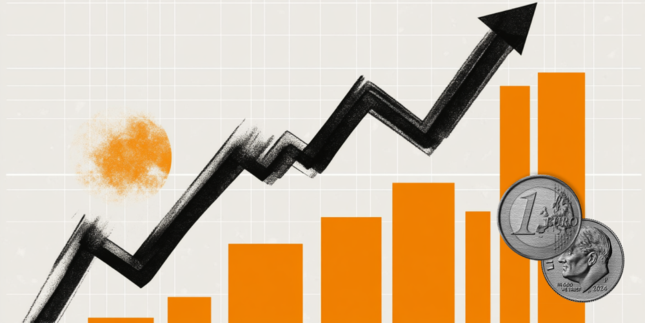- The Japanese Yen hangs near a multi-decade against the USD amid the BoJ’s dovish outlook.
- The divergent Fed-BoJ expectations support prospects for a further JPY depreciation move.
- Intervention fears hold back the JPY bears from placing fresh bets and cap the USD/JPY pair.
The Japanese Yen (JPY) extends the sideways consolidative price move against its American counterpart and languishes near a multi-decade low heading into the European session on Tuesday. the Bank of Japan's (BoJ) cautious approach and uncertain outlook for future rate hikes, along with speculations that the Federal Reserve (Fed) could delay cutting interest rates, suggests that the gap between US and Japanese rates will stay wide. This, along with a generally positive tone around the equity markets, continues to undermine demand for the safe-haven JPY.
The US Dollar (USD), on the other hand, draws some support from elevated US Treasury bond yields, bolstered by reduced bets for the total number of Fed rate cuts in 2024. This, in turn, is seen as another factor acting as a tailwind for the USD/JPY pair. Investors, however, remain on alert in the wake of the possibility that Japanese authorities will intervene in the market to prevent a destabilizing fall in the domestic currency. This, in turn, helps limit losses for the JPY as traders look to the release of the US consumer inflation figures and the FOMC minutes on Wednesday for a fresh impetus.
Daily Digest Market Movers: Japanese Yen is undermined by dovish BoJ, bears seem reluctant amid intervention fears
- The recent jawboning from Japanese authorities, showing readiness to intervene in the markets to address any excessive falls in the domestic currency, helps limit the downside for the Japanese Yen.
- Japan's Prime Minister Fumio Kishida said on Friday that excessive volatility in currency rates is undesirable and warned that authorities will use all available means to deal with excessive JPY falls.
- Japan Finance Minister Suzuki reiterated on Monday that FX needs to move stably reflecting fundamentals and he won't rule out any option, and will deal appropriately with FX moves.
- The Bank of Japan's (BoJ) cautious approach, indicating that accommodative financial conditions will be maintained for an extended period, fails to assist the JPY in attracting any meaningful buying.
- Moreover, data released on Monday showed that inflation-adjusted real wages for Japanese workers fell in February for the 23rd consecutive month and further contributed to keeping a lid on the JPY.
- The optimism over talks on a potential Israel-Hamas ceasefire remains limited in the wake of Israeli Prime Minister Benjamin Netanyahu's threat of a ground invasion in the southern Gaza city of Rafah.
- The upbeat US jobs report released on Friday, along with the recent hawkish remarks by Federal Reserve officials, keeps the US Treasury bond yields elevated and acts as a tailwind for the US Dollar.
- The US Treasury bond yields climbed to their highest levels since late November as investors continue scaling back their bets for how deeply the Fed will be able to cut interest rates this year.
- Chicago Fed President Austan Goolsbee acknowledged on Monday that the US economy remains strong but wondered how long the central bank can be restrictive without damaging the economy.
- Minneapolis President Neel Kashkari said that the central bank cannot stop short on the inflation fight and that the labor market is not red hot like it was 12 months ago but its still tight.
Technical Analysis: USD/JPY consolidates in a two-week-old trading range, bullish potential seems intact
From a technical perspective, the range-bound price action witnessed over the past three weeks or so might still be categorized as a bullish consolidation phase against the backdrop of the recent rally from the March swing low. Moreover, oscillators on the daily chart are holding in the positive territory and are still away from being in the overbought zone, suggesting that the path of least resistance for the USD/JPY pair is to the upside. That said, it will still be prudent to wait for a sustained move and acceptance above the 152.00 mark before positioning for any further gains.
In the meantime, any corrective pullback is more likely to find some support and be bought into near the 151.30 horizontal zone. This should help limit the downside for the USD/JPY pair near the 151.00 mark. A convincing break below the latter, however, might prompt some technical selling and expose Friday's swing low, around the 150.30 region. This is followed by the 150.00 psychological mark, which, if broken decisively, will shift the near-term bias in favor of bearish traders. Spot prices might then accelerate the fall to the 149.35-149.30 region en route to the 149.00 mark.
Fed FAQs
Monetary policy in the US is shaped by the Federal Reserve (Fed). The Fed has two mandates: to achieve price stability and foster full employment. Its primary tool to achieve these goals is by adjusting interest rates. When prices are rising too quickly and inflation is above the Fed’s 2% target, it raises interest rates, increasing borrowing costs throughout the economy. This results in a stronger US Dollar (USD) as it makes the US a more attractive place for international investors to park their money. When inflation falls below 2% or the Unemployment Rate is too high, the Fed may lower interest rates to encourage borrowing, which weighs on the Greenback.
The Federal Reserve (Fed) holds eight policy meetings a year, where the Federal Open Market Committee (FOMC) assesses economic conditions and makes monetary policy decisions. The FOMC is attended by twelve Fed officials – the seven members of the Board of Governors, the president of the Federal Reserve Bank of New York, and four of the remaining eleven regional Reserve Bank presidents, who serve one-year terms on a rotating basis.
In extreme situations, the Federal Reserve may resort to a policy named Quantitative Easing (QE). QE is the process by which the Fed substantially increases the flow of credit in a stuck financial system. It is a non-standard policy measure used during crises or when inflation is extremely low. It was the Fed’s weapon of choice during the Great Financial Crisis in 2008. It involves the Fed printing more Dollars and using them to buy high grade bonds from financial institutions. QE usually weakens the US Dollar.
Quantitative tightening (QT) is the reverse process of QE, whereby the Federal Reserve stops buying bonds from financial institutions and does not reinvest the principal from the bonds it holds maturing, to purchase new bonds. It is usually positive for the value of the US Dollar.
Information on these pages contains forward-looking statements that involve risks and uncertainties. Markets and instruments profiled on this page are for informational purposes only and should not in any way come across as a recommendation to buy or sell in these assets. You should do your own thorough research before making any investment decisions. FXStreet does not in any way guarantee that this information is free from mistakes, errors, or material misstatements. It also does not guarantee that this information is of a timely nature. Investing in Open Markets involves a great deal of risk, including the loss of all or a portion of your investment, as well as emotional distress. All risks, losses and costs associated with investing, including total loss of principal, are your responsibility. The views and opinions expressed in this article are those of the authors and do not necessarily reflect the official policy or position of FXStreet nor its advertisers. The author will not be held responsible for information that is found at the end of links posted on this page.
If not otherwise explicitly mentioned in the body of the article, at the time of writing, the author has no position in any stock mentioned in this article and no business relationship with any company mentioned. The author has not received compensation for writing this article, other than from FXStreet.
FXStreet and the author do not provide personalized recommendations. The author makes no representations as to the accuracy, completeness, or suitability of this information. FXStreet and the author will not be liable for any errors, omissions or any losses, injuries or damages arising from this information and its display or use. Errors and omissions excepted.
The author and FXStreet are not registered investment advisors and nothing in this article is intended to be investment advice.
Recommended content
Editors’ Picks

AUD/USD: Momentum favours further gains
In line with the broad recovery in the risk-linked complex, AUD/USD left behind a two-day negative streak and resumed its uptrend towards the 0.6400 region, always on the back of the resurgence of quite a strong downside pressure hitting the US Dollar on Thursday.

EUR/USD: Extra advances appear in the pipeline
EUR/USD followed the widespread improved sentiment in the risk-linked galaxy and managed to set aside two daily drops in a row and refocus on the upper end of its recent range around the 1.1400 zone on Thursday.

Gold price climbs past $3,300 on uncertainty about trade and weak USD
Gold snaps two-day losing streak, gaining 1.5% on fresh trade war fears. Trump softens tariff talk, but China denies negotiations and demands full rollback. Fed rate cut bets rise as yields drop and economic uncertainty builds.

Ondo Finance hits $3B market cap as CEO Nathan Allman meets SEC to discuss tokenized US securities
Ondo Finance met with officials of the SEC and the law firm Davis Polk to discuss the regulation of tokenized US securities. Topics included registration requirements, broker-dealer rules and proposed compliant models for tokenized securities issuance.

Five fundamentals for the week: Traders confront the trade war, important surveys, key Fed speech Premium
Will the US strike a trade deal with Japan? That would be positive progress. However, recent developments are not that positive, and there's only one certainty: headlines will dominate markets. Fresh US economic data is also of interest.

The Best brokers to trade EUR/USD
SPONSORED Discover the top brokers for trading EUR/USD in 2025. Our list features brokers with competitive spreads, fast execution, and powerful platforms. Whether you're a beginner or an expert, find the right partner to navigate the dynamic Forex market.



